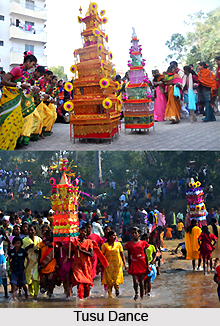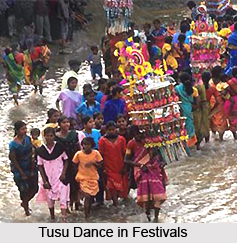 Tusu Dance is a folk dance popular in West Bengal state of India. It is mostly practiced in group and men and women equally participate in this dance. It is performed during the harvest festival to celebrate the coming crop. Tusu dance is also popular in various other districts of West Bengal such as Purulia and Medinipur.
Tusu Dance is a folk dance popular in West Bengal state of India. It is mostly practiced in group and men and women equally participate in this dance. It is performed during the harvest festival to celebrate the coming crop. Tusu dance is also popular in various other districts of West Bengal such as Purulia and Medinipur.
This tribal dance which derived its origin from the cultural roots of Birbhum district is basically related to the Tusu Parab or Tusu Festival. The Tusu Parab is held in Birbhum on the occasion of Makar Sankranti where in its performance groups of young girls gather every evening throughout the month of Pousa which falls on December-January and participate in singing various local songs and dance to their rhythm. The local songs are popularly known as Tusu in Bengal. While performing, some of the girls sing devotional verses and some others dance in sync with the vocal melodies.
 On the day of Makara Sankranti, the groups gather at one place and go to the village to a nearby tank or river with the goddess Tusu symbolized in small clay figurines or sometimes merely as cow-dung balls. After taking a sacred bath, they all worship the goddess and make offerings of rice to the deity as a token of respect and love. Different groups meet, sing songs near the riverbank or the pond and compete with each other. This creates an environment of happiness. Tusu Parab in Bengal does not involve any kind of musical instrument as such. This dance is enriched by vocal variations only. The men too have their particular songs and dances for the occasion, known as the Bhaduriya Saila. The performance of the dance is more traditional in nature, where the men dance in circles clock-wise and anti-clockwise direction.
On the day of Makara Sankranti, the groups gather at one place and go to the village to a nearby tank or river with the goddess Tusu symbolized in small clay figurines or sometimes merely as cow-dung balls. After taking a sacred bath, they all worship the goddess and make offerings of rice to the deity as a token of respect and love. Different groups meet, sing songs near the riverbank or the pond and compete with each other. This creates an environment of happiness. Tusu Parab in Bengal does not involve any kind of musical instrument as such. This dance is enriched by vocal variations only. The men too have their particular songs and dances for the occasion, known as the Bhaduriya Saila. The performance of the dance is more traditional in nature, where the men dance in circles clock-wise and anti-clockwise direction.
In some parts, the unmarried girls perform it. For them, Tusu, performed with graceful movements and elegance fulfils their desire of marriage. The Tusu dance has its tremendous store of songs, which reflect different stories and the experiences of livelihood. Tusu dance comprises of simple movements and the songs are deeply related with nature and provide spirit for living.



















